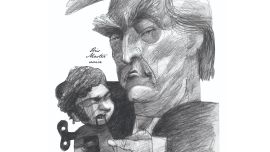The World Cup kicking off in Qatar tomorrow is almost universally viewed as a massive distraction from everything else but it could equally be viewed as reflecting this country’s problems as much as diverting attention from them. If corruption is a major issue here as the Santa Cruz highway tender graft trial against Vice-President Cristina Fernández de Kirchner heads towards its climax amid all her manoeuvres on a broader judicial front, the improbable World Cup venue of Qatar should serve as a constant reminder of the force of corruption – what explanation other than the strategic allocation of petro-dollars could explain the choice of a sheikdom bereft of any football traditions with an adverse climate distorting the sporting calendar worldwide and geographic restrictions (the first World Cup to be held in a single city since 1930 in Uruguay where this tournament began)?
Qatar has also given its name to the steepest of the umpteen exchange rates proliferating in recent times and this brings us to the monetary and economic problems in a week when the INDEC national statistics bureau announced the continent’s worst October inflation figure of 6.3 percent (minimally ahead of Venezuela’s 6.2 percent), accompanied by the “blue” parallel exchange rate shooting beyond the 300-peso mark, a level which the so-called “Qatar dollar” for tourism abroad was already well above when introduced just over a month ago.
The October figure has confirmed inflation at a new plateau of six to seven percent doubling the three to four percent in the first half of the year (a magnitude to which the government aspires to return via the “Precios Justos” price restraints in the next four months instead of reducing inflation to the levels of the rest of the world). The new Labour Minister Kelly Olmos has been widely criticised for saying that the struggle against inflation might have to wait a few weeks because everybody will be absorbed by the World Cup but would that it were so simple – if the government were to tame inflation just in time for Christmas instead of now because the populace is so fascinated by the two Lionels, who could complain? But the problem is far more complex.
The surge of the “blue” dollar effectively ends more than three months of relative monetary calm maintained by Economy Minister Sergio Massa despite no apparent success against inflation. The reasons for this surge can be described as “multi-causal,” a term this government’s economic team is so fond of using for inflation. Despite an ailing President Alberto Fernández giving maximum priority to meeting International Monetary Fund (IMF) Managing Director Kristalina Georgieva during his G20 sojourn in Bali within an agenda restricted by gastritis, Argentina’s main risks currently lie in peso rather than dollar debt since obtaining rollovers from the IMF seems to be pushing at an open door. In contrast, peso bonds and the resulting quasi-fiscal deficit cannot be underestimated as prime causes of swelling the peso demand for the dollar. Urged on by his deputy minister, Economic Planning Secretary Gabriel Rubinstein, Massa had every intention of imposing a restrictive monetary policy upon taking office but the sheer volume of the bonds needed to keep the Treasury afloat is forcing him into expansion – just the last batch of Leliqs obliged the Central Bank to print almost a quarter trillion pesos, dimensions on the scale of the “plan platita” of last year’s midterms which contributed so much to the three-digit annual inflation expected for this year.
The effects of this glut of pesos would be less dramatic if the government were not at the same time restricting imports in order to nurse scant Central Bank reserves – the pesos previously earmarked for purchasing the official dollars required for inputs now go in pursuit of the unofficial versions. Furthermore, the hampered flow of inputs will inevitably reduce the supply of goods to meet an inflated peso demand, quite apart from the next harvest still not being free from the shadow of drought.
With fiscal, monetary, commercial and industrial policies out of sync, a crisis (or even hyperinflation, as Rubinstein recently hinted) could be only just around the corner but whoops, we almost forgot – the World Cup in Qatar is even more around the corner so what else matters?


















Comments